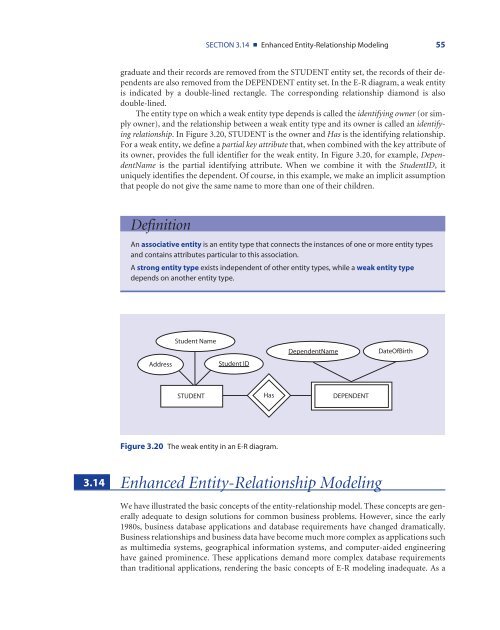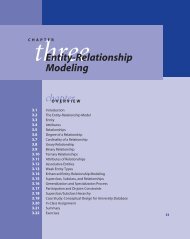Web-DSS-Chapter-03
Web-DSS-Chapter-03
Web-DSS-Chapter-03
Create successful ePaper yourself
Turn your PDF publications into a flip-book with our unique Google optimized e-Paper software.
SECTION 3.14 ■ Enhanced Entity-Relationship Modeling 55<br />
graduate and their records are removed from the STUDENT entity set, the records of their dependents<br />
are also removed from the DEPENDENT entity set. In the E-R diagram, a weak entity<br />
is indicated by a double-lined rectangle. The corresponding relationship diamond is also<br />
double-lined.<br />
The entity type on which a weak entity type depends is called the identifying owner (or simply<br />
owner), and the relationship between a weak entity type and its owner is called an identifying<br />
relationship. In Figure 3.20, STUDENT is the owner and Has is the identifying relationship.<br />
For a weak entity, we define a partial key attribute that, when combined with the key attribute of<br />
its owner, provides the full identifier for the weak entity. In Figure 3.20, for example, DependentName<br />
is the partial identifying attribute. When we combine it with the StudentID, it<br />
uniquely identifies the dependent. Of course, in this example, we make an implicit assumption<br />
that people do not give the same name to more than one of their children.<br />
Definition<br />
An associative entity is an entity type that connects the instances of one or more entity types<br />
and contains attributes particular to this association.<br />
A strong entity type exists independent of other entity types, while a weak entity type<br />
depends on another entity type.<br />
Address<br />
Student Name<br />
Student ID<br />
DependentName<br />
DateOfBirth<br />
STUDENT<br />
Has<br />
DEPENDENT<br />
Figure 3.20 The weak entity in an E-R diagram.<br />
3.14 Enhanced Entity-Relationship Modeling<br />
We have illustrated the basic concepts of the entity-relationship model. These concepts are generally<br />
adequate to design solutions for common business problems. However, since the early<br />
1980s, business database applications and database requirements have changed dramatically.<br />
Business relationships and business data have become much more complex as applications such<br />
as multimedia systems, geographical information systems, and computer-aided engineering<br />
have gained prominence. These applications demand more complex database requirements<br />
than traditional applications, rendering the basic concepts of E-R modeling inadequate. As a



